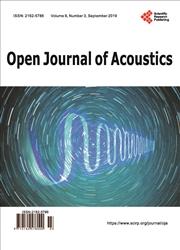The Role of Efferent Reduction of Cochlear Compression in the Detection of Tones in Noise
引用次数: 0
Abstract
Stimulation of medial olivocochlear (MOC) efferent neurons reduces basilar membrane (BM) sensitivity and increases the slope of BM input-output (I/O) functions in animal models. Decreased compression of I/O functions associated with activation of MOC efferent neurons may assist in extending the neural response to the tone above that of noise, leading to an improvement in masked thresholds. To evaluate this hypothesis, the distortion-product otoacoustic emission (DPOAE) I/O function, a proxy measure of BM compression, was examined in conditions with presentation of contralateral noise. DPOAE I/O functions were measured at f2 frequencies of 1000 and 2000 Hz in 16 normal-hearing adults. In each subject, estimation of masked thresholds at 1000 and 2000 Hz was provided by a two-interval forced-choice procedure. There were statistically significant associations between DPOAE I/O function slopes and masked tone thresholds at both 1000 and 2000 Hz. At 1000 Hz, individuals with higher DPOAE I/O function slopes exhibited lower masked thresholds. Data at 2000 Hz indicated that individuals with higher masked thresholds exhibited higher DPOAE I/O function slopes. When measured with contralateral noise, DPOAE I/O function slopes were linked to masked thresholds at both frequencies examined in this study. Linearized DPOAE I/O functions presumably reflect linearized BM growth functions under conditions of MOC efferent activation, and this process may have extended the neural response to the signal tone so that it could be more easily heard in the presence of masking noise under certain conditions examined in this study.耳蜗压缩的传出减少在噪声中音调检测中的作用
在动物模型中,对内侧橄榄耳蜗(MOC)传出神经元的刺激降低了基底膜(BM)的敏感性,并增加了BM输入输出(I/O)功能的斜率。与MOC传出神经元激活相关的I/O功能的压缩减少可能有助于将神经反应扩展到高于噪声的音调,从而改善掩蔽阈值。为了评估这一假设,在存在对侧噪声的条件下,对失真产物耳声发射(DPOAE)I/O功能(BM压缩的一种替代测量)进行了检查。在16名听力正常的成年人中,在1000和2000Hz的f2频率下测量DPOAE I/O功能。在每个受试者中,通过两个间隔的强制选择程序提供1000和2000 Hz的掩蔽阈值的估计。在1000和2000 Hz的DPOAE I/O功能斜率和掩蔽音调阈值之间存在统计学上显著的相关性。在1000Hz下,具有较高DPOAE I/O功能斜率的个体表现出较低的掩蔽阈值。2000Hz的数据表明,具有较高掩蔽阈值的个体表现出较高的DPOAE I/O功能斜率。当用对侧噪声测量时,DPOAE I/O功能斜率与本研究中检查的两个频率的掩蔽阈值相关。线性化DPOAE I/O函数可能反映了在MOC传出激活条件下的线性化BM生长函数,并且该过程可能扩展了对信号音的神经反应,从而在本研究中检查的某些条件下,在存在掩蔽噪声的情况下更容易听到信号音。
本文章由计算机程序翻译,如有差异,请以英文原文为准。
求助全文
约1分钟内获得全文
求助全文

 求助内容:
求助内容: 应助结果提醒方式:
应助结果提醒方式:


